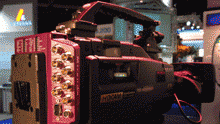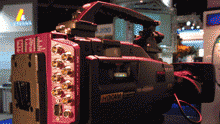HD AND SD conversion

HD AND SD conversion

Some new converters attach to HD cameras to allow on-set monitoring with low-cost SD monitors. Photo courtesy Miranda.
Since the early ‘80s, we've been hearing that digital TV is just around the corner. It turns out that the corner was much farther away than we thought. Today, we live in a transitional world. The transition from NTSC to ATSC has begun in earnest, but we still have one foot in the past and one foot in the future.
The United States, Japan and a few other countries exhibit a sense of excitement about ATSC production and distribution. But, today, advertising and licensing revenue still comes almost exclusively from the composite, standard-definition release of productions, whether on terrestrial broadcast, satellite broadcast, VHS or DVD. The inescapable conclusion is that, for the foreseeable future, the broadcast and production industries will need reliable, high-quality, affordable conversion solutions that allow them to repurpose content between and among 525/625 and ATSC formats.
The basic techniques for ATSC conversions are no different than those used for 525/625 conversions. But, with ATSC, the number of allowable formats has grown considerably. And the number of possible format conversions has grown tremendously. Figure 1, which shows (the infamous) ATSC document A-53A Table 3 and its accompanying legend, reveals the multitude of allowable digital TV formats.
Note that 1088 lines are actually coded to satisfy the MPEG-2 requirement that the coded vertical size be a multiple of 16 (for progressive scan) or 32 (for interlaced scan).
Temporal troubles
Field-rate conversion is “a fine kettle of fish.” For example, converting film's 24f/s to TV's 30f/s is something with which all of us are familiar. The 3/2 pulldown process involved in the conversion doesn't render motion faithfully. The syncopated rhythm of the 3/2 cadence interrupts motion and, with some scenes, it can become quite annoying. The answer is to perform a motion-compensated interpolation between pairs of frames using knowledge of preceding and subsequent frames to render the motion more smoothly. Similar issues exist when converting between PAL (625/25i) and NTSC (525/30i).
Get the TV Tech Newsletter
The professional video industry's #1 source for news, trends and product and tech information. Sign up below.
Figure 1. ATSC document A-53A Table 3 and its accompanying legend reveal the multitude of digital TV formats. (Reproduced courtesy of ATSC.)
Converting film for TV is simple when compared with some ATSC conversions. Ironically, the most onerous ATSC conversion is the one that, at first glance, seems the easiest. Converting 720p60 to 720p59.94 might appear to be easy because the ratio of the frame rates yields a 0.1 percent difference. We could just skip one frame in a thousand (or repeat one frame in a thousand to convert 720p59.94 to 720p60), but dropping or adding a frame might not meet with the producer's approval. An alternative might be to employ interpolation, perhaps with motion compensation, in the conversion. But in this case, the number of frames the algorithm requires to render the content smoothly can be quite substantial, perhaps eight or more frames in memory for review and processing.
The problems that these examples point out are not restricted to ATSC formats; rather, they highlight the difficulty conversions present in some production situations. To avoid or help alleviate such problems, manufacturers of ATSC converters might have to provide algorithms capable of converting among all ATSC formats. Panasonic, Teranex, Snell & Wilcox, Evertz, Miranda and Sony all make converters, and three of them (Teranex, Panasonic, and Snell & Wilcox) make converters for the full range of formats. For example, Figure 2 shows the conversion chart for a Panasonic converter that can perform more than 90 bi-directional conversions.
Figure 2. The conversion chart for one of Panasonic’s converters shows that it can perform more than 90 bi-directional conversions.
If spatial and temporal conversions were the only issues with which converter designers had to contend, format conversion would be less problematic. But they must also consider such picture-related parameters as aspect ratio, colorimetry, image content and audio handling.
Aspect ratio
Most of our TV viewing experience has been with NTSC and PAL, which both use the 4:3 (1.333:1) aspect ratio. The ATSC has standardized the aspect ratio of HDTV in North America as 16:9 (1.77:1). Motion pictures on film are shot in a variety of even wider aspect ratios, including 1.85:1 and 2.35:1. Converting content between aspect ratios presents both technical and production issues.
Figure 3. This display shows the effects of aspect-ratio conversions on the image.
Conversions between aspect ratios have the most noticeable effect on the image. Figure 3 illustrates these effects. For example, downconverting from 16:9 to 4:3 cuts off the sides of the 16:9 image. Most motion pictures are converted for viewing on a 4:3 aspect-ratio screen using the pan-and-scan process. The other choice, favored by many moviemakers, is to employ the letterbox process. This process shrinks the entire image, but preserves the aspect ratio of the original film.
Converting between square-pixel formats and non-square-pixel formats presents technical issues. Non-square pixels complicate the math needed to convert aspect ratios and special resolutions.
Colorimetry
Colorimetry is a parameter that is often overlooked, but is nonetheless critical to converting between SD and HD formats properly. Today, we have three relevant colorimetry standards and, unfortunately, two of them relate to legacy and current HDTV equipment. Figure 4 shows several TV scanning standards and the luma equations that TV equipment (including converters) should use to maintain correct colorimetry. The early HDTV equipment that had 1035 active lines should conform to SMPTE 240M, while all current systems should be using ITU-R BT.709 colorimetry (often called Rec. 709). A converter may have the smarts to look at the input and output formats and select the correct matrices to transform the color between standards. However, if a 1035i camera is used to produce part of a 1080i program, it may not produce the right colorimetry to match the display format that the converter automatically senses.
Image content
Clearly, an upconversion from 480i or 576i to HDTV cannot generate the detail an HDTV original would produce. But, with high-quality interpolation, it can provide a dramatic improvement over the low-resolution original. Designers of conversion systems must take special care to ensure that their devices do not create spectral energy that causes aliases with the original.
What about sound?
Ideally, converters should be capable of handling all types of audio. This includes analog, discrete AES inputs, and embedded audio. All SD/HD converters will pass and re-embed the signals on the output. It is important that the converter compensates for the latency (electrical delay) of the audio signal(s) as it does for the video signal.
Figure 4. SMPTE engineering guideline EG36-2000 shows several TV scanning standards and the luma equations that video equipment (including converters) should use to maintain correct colorimetry.
Many major manufacturers of conversion devices have implemented only four channels for discrete AES inputs, limiting the output to eight of the available 16 channels. Discrete audio for surround sound requires only three AES pairs, though many producers assign L, R, C, L S, R S, LFE, and L T, R T (Left Total (i.e. consumer surround-sound encoded). So you should use care when considering converters that can handle only two channels. The new underclass
Additionally, there is a subclass of converters to consider. Several manufacturers (Thomson Grass Valley, Leitch, Miranda, Evertz, Snell & Wilcox, Aja Video and Cobalt Digital, among others) make card-based upconverters and downconverters. The downconverters are available with “monitor only” performance as well as with full 10-bit adaptive conversion. These exciting products allow 525 monitors to monitor high-bandwidth signals, though at lower quality. They can also save large amounts of money if the SD output is employed for non-critical uses only. For instance, you can use a monitoring downconverter to feed a nonlinear editing system at acceptable quality and thus make edit decisions without requiring a higher-cost, full-resolution edit solution. Such a downconverter can also be used to feed low-bit-rate encoders for streaming video in a cost-effective manner. Several manufacturers (Miranda among them) also make converters in a form factor intended to attach to HD cameras to allow low-cost monitors to be used on set. The new Miranda unit even outputs DV on Firewire for input to laptop editors on the set.
Ten years ago, converters cost upwards to $250,000. Today, they can cost well under $10,000. As solutions are committed to silicon, we may soon see conversion embedded in other production devices for little additional money. The flexibility of current converters is bringing us closer to that corner where we can see digital TV.
John Luff is senior vice president of business development for AZCAR. To reach him, visitwww.azcar.com.
Home | Back to the top | Write us
Send questions and comments to:john_luff@primediabusiness.com
